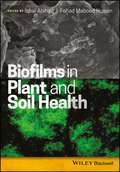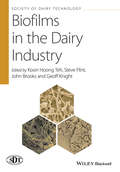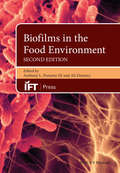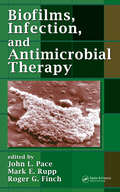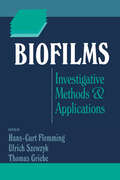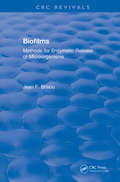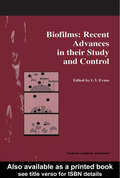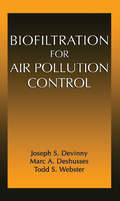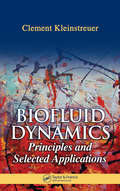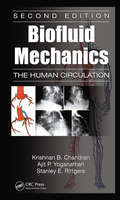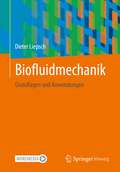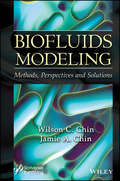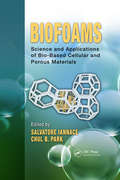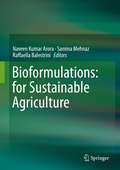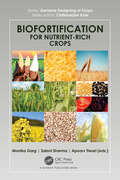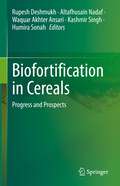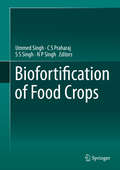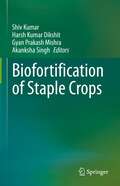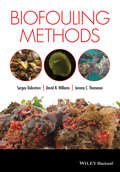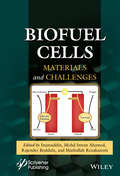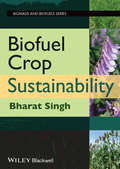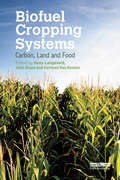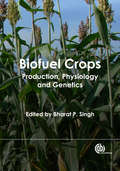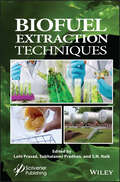- Table View
- List View
Biofilms in Plant and Soil Health
by Iqbal Ahmad Fohad Mabood HusainBiofilms are predominant mode of life for microbes under natural conditions. The three-dimensional structure of the biofilm provides enhanced protection from physical, chemical and biological stress conditions to associated microbial communities. These complex and highly structured microbial communities play a vital role in maintaining the health of plants, soils and waters. Biofilm associated with plants may be pathogenic or beneficial based on the nature of their interactions. Pathogenic or undesirable biofilm requires control in many situations, including soil, plants, food and water. Written by leading experts from around the world, Biofilms in Plant and Soil Health provides an up-to-date review on various aspects of microbial biofilms, and suggests future and emerging trends in biofilms in plant and soil health.Issues are addressed in four sub areas: I) The fundamentals and significance of biofilm in plant and soil health, and the concept of mono and mixed biofilms by PGPR and fungal biofilms. II) Biochemical and molecular mechanisms in biofilm studies in plant associated bacteria, and techniques in studying biofilms and their characterization, gene expression and enhanced antimicrobial resistance in biofilms, as well as biotic and biotic factors affecting biofilm in vitro. III) The ecological significance of soil associated biofilms and stress management and bioremediation of contaminated soils and degraded ecosystems. IV) Pathogenic biofilm associated with plant and food and its control measures. This book is recommended for students and researchers working in agricultural and environmental microbiology, biotechnology, soil sciences, soil and plant health and plant protection. Researchers working in the area of quorum sensing, biofilm applications, and understanding microbiome of soil and plants will also find it useful.
Biofilms in the Dairy Industry (Society of Dairy Technology)
by John Brooks Koon Hoong Teh Steve Flint Geoff KnightIn recent years, the formation and impacts of biofilms on dairy manufacturing have been studied extensively, from the effects of microbial enzymes produced during transportation of raw milk to the mechanisms of biofilm formation by thermophilic spore-forming bacteria. The dairy industry now has a better understanding of biofilms and of approaches that may be adopted to reduce the impacts that biofilms have on manufacturing efficiencies and the quality of dairy products. Biofilms in the Dairy Industry provides a comprehensive overview of biofilm-related issues facing the dairy sector. The book is a cornerstone for a better understanding of the current science and of ways to reduce the occurrence of biofilms associated with dairy manufacturing. The introductory section covers the definition and basic concepts of biofilm formation and development, and provides an overview of problems caused by the occurrence of biofilms along the dairy manufacturing chain. The second section of the book focuses on specific biofilm-related issues, including the quality of raw milk influenced by biofilms, biofilm formation by thermoduric streptococci and thermophilic spore-forming bacteria in dairy manufacturing plants, the presence of pathogens in biofilms, and biofilms associated with dairy waste effluent. The final section of the book looks at the application of modelling approaches to control biofilms. Potential solutions for reducing contamination throughout the dairy manufacturing chain are also presented. Essential to professionals in the global dairy sector, Biofilms in the Dairy Industry will be of great interest to anyone in the food and beverage, academic and government sectors. This text is specifically targeted at dairy professionals who aim to improve the quality and consistency of dairy products and improve the efficiency of dairy product manufacture through optimizing the use of dairy manufacturing plant and reducing operating costs.
Biofilms in the Food Environment
by Anthony L. Pometto III Ali DemirciIn nature, microorganisms are generally found attached to surfaces as biofilms such as dust, insects, plants, animals and rocks, rather than suspended in solution. Once a biofilm is developed, other microorganisms are free to attach and benefit from this microbial community. The food industry, which has a rich supply of nutrients, solid surfaces, and raw materials constantly entering and moving through the facility, is an ideal environment for biofilm development, which can potentially protect food pathogens from sanitizers and result in the spread of foodborne illness. Biofilms in the Food Environment is designed to provide researchers in academia, federal research labs, and industry with an understanding of the impact, control, and hurdles of biofilms in the food environment. Key to biofilm control is an understanding of its development. The goal of this 2nd edition is to expand and complement the topics presented in the original book. Readers will find: The first comprehensive review of biofilm development by Campylobacter jejuni An up-date on the resistance of Listeria monocytogenes to sanitizing agents, which continues to be a major concern to the food industry An account of biofilms associated with various food groups such as dairy, meat, vegetables and fruit is of global concern A description of two novel methods to control biofilms in the food environment: bio-nanoparticle technology and bacteriophage Biofilms are not always a problem: sometimes they even desirable. In the human gut they are essential to our survival and provide access to some key nutrients from the food we consume. The authors provide up-date information on the use of biofilms for the production of value-added products via microbial fermentations. Biofilms cannot be ignored when addressing a foodborne outbreak. All the authors for each chapter are experts in their field of research. The Editors? hope is that this second edition will provide the bases and understanding for much needed future research in the critical area of ?Biofilm in Food Environment?.
Biofilms, Infection, and Antimicrobial Therapy
by Roger G. Finch John L. Pace Mark E. RuppRather than existing in a planktonic or free-living form, evidence indicates that microbes show a preference for living in a sessile form within complex communities called biofilms. Biofilms appear to afford microbes a survival advantage by optimizing nutrition, offering protection against hostile elements, and providing a network for cell-to-cell
Biofilms: Investigative Methods and Applications
by Hans-Curt Flemming Ulrich Szewzyk Thomas GriebeUntil now, techniques for studying biofilms- the cellular colonies that live in drinking water systems, wastewater operations, even ground and surface water- have been limited. Yet during the last decade, biofilms have become a critical element in water quality preservation systems, a key component of wastewater treatment biological reactions and t
Biofilms: Methods for Enzymatic Release of Microorganisms (CRC Press Revivals)
by Jean F. BrisouThis text presents a new technique for detecting microorganisms, specifically bacteria found in all levels of the biosphere. It also discusses methods for enzymatic release of these microbes as well as their interactions in all ecosystems. Drawings and micrographs help to illustrate this concept.Part one is devoted to the mechanisms of adherence. The second part discusses microbial ecology and the bacterial population of tissues as well as both land and aquatic microbiocenoses in general. Part three specifically covers technique. What is known about the mechanisms of adherence justifies the choice of techniques suggested. Applications in areas such as nature, medicine, environmental hygiene and the food industry are discussed. The explanation of useful techniques, the author's research results, and practical application methods make this volume an essential reference tool for researchers, technicians and practitioners.
Biofilms: Recent Advances in their Study and Control
by L. V. EvansBiofilms affect the lives of all of us, growing as they do for example on our teeth (as plaque), on catheters and medical implants in our bodies, on our boats and ships, in food processing environments, and in drinking and industrial water treatment systems. They are highly complex biological communities whose detailed structure and functioning is
Biofiltration for Air Pollution Control
by Joseph S. Devinny Marc A. Deshusses Todd Stephen WebsterThe number-one environmental threat to public health, air pollution remains a pressing problem-made even more complicated by the massive quantity and diversity of air pollution sources.Biofiltration technology (using micro-organisms growing on porous media) is being recognized as one of the most advantageous means to convert pollutants to harmless products. Done properly, biofiltration works at a reasonable cost-utilizing inexpensive components, without requiring fuel or generating hazardous by-products.Firmly established in Europe, biofiltration techniques are being increasingly applied in North America: Biofiltration for Air Pollution Control offers the necessary knowledge to "do it right."
Biofluid Dynamics: Principles and Selected Applications
by Clement KleinstreuerBiofluid Dynamics builds a solid understanding of medical implants and devices from a bioengineering standpoint. The text features extensive worked examples and mathematical appendices; exercises and project assignments to stimulate critical thinking and build problem solving skills; numerous illustrations, including a 16-page full-color insert; computer simulations of biofluid dynamics processes and medical device operations; tools for solving basic biofluid problems; and a glossary of terms. The text can be used as a primary selection for a comprehensive course or for a two-course sequence or as a reference for professionals in biomedical engineering and medicine.
Biofluid Mechanics: The Human Circulation, Second Edition
by Krishnan B. Chandran Ajit P. Yoganathan Stanley E. RittgersDesigned for senior undergraduate or first-year graduate students in biomedical engineering, Biofluid Mechanics: The Human Circulation, Second Edition teaches students how fluid mechanics is applied to the study of the human circulatory system. Reflecting changes in the field since the publication of its predecessor, this second edition has been ex
Biofluidmechanik: Grundlagen und Anwendungen
by Dieter LiepschDieses Buch führt Sie in die Grundlagen der Biofluidmechanik einWie funktioniert der menschliche Blutkreislauf? Wie arbeiten Mikrozirkulationsvorgänge? Mit diesen und vielen weiteren Fragen der Strömungsuntersuchung beschäftigt sich die Biofluidmechanik. Dieses Buch gewährt ihnen interessante Einblicke in die Grundlagen der Biofluidmechanik.Die Biofluidmechanik ist eine thematisch sehr breit gestaffelte Wissenschaft. Sie erforscht die Gesetzmäßigkeiten der Bewegung, des Kräftegleichgewichtes und der Strömungstechnik von Fluiden. Hierzu gehören unter anderem:• Atmung• Blutkreislauf• Mikrozirkulationsvorgänge• Lymphströmungen• Künstliche Gefäßersatze• Gefäßprothesen aus verschiedenen Materialien• Künstliche Herzklappen• Urologische Messungen• Künstliche Harnleiter• Blutrheologie• Transport durch Membranen• Bewegung geladener Partikel• Ionen in Lösungen• Vibrationen• Wellenfortpflanzung und SchockwellenWichtiges Grundlagenwissen der Biofluidmechanik in einem Buch In seinem Buch gibt der Autor einen ausführlichen Überblick über die Grundlagen der Biofluidmechanik und stellt die folgenden Themen detailliert vor:• Einleitung in die Biofluidmechanik• Physikalische Grundlagen von Fluiden• Rheologische Grundlagen• Biofluide (Körperflüssigkeiten) in Menschen und Tieren• Grundlegende theoretische Fluid- bzw. hämodynamische Betrachtungen• Medizinische Grundlagen, menschliches Kreislaufsystem, Blutgefäße, Herz, Lungenmechanik und Atmung• Besonderheiten und Messmethoden der Biofluidmechanik• Anwendungen und Beispiele in Modellen, diagnostische und therapeutische BedeutungAufgrund des hohen Praxisbezugs ist dieses Buch über die Biofluidmechanik nicht nur für Studenten, sondern auch für Beschäftigte in Gesundheitsforschung und Medizin ein wichtiges und hilfreiches Grundlagenwerk.
Biofluids Modeling: Methods, Perspectives, and Solutions
by Wilson C. Chin Jamie A. ChinBIOFLUIDS MODELING The first book offering analytical and modern computational solutions to important biofluids problems, such as non-Newtonian flows in blood vessels, clogged arteries and veins, bifurcated arteries and veins, arbitrary stent geometries, tissue properties prediction, and porous media Darcy flow simulation in large-scale organ analysis, this is a must-have for any library. This book introduces new methods for biofluids modeling and biological engineering. The foregoing subjects are treated rigorously, with all modeling assumptions stated and solutions clearly derived. But that’s not all. Key supporting physics-based ideas, algorithmic details, and software design interfaces are equally emphasized, in order to support our overriding objective of getting the anatomical and clinical information that physicians need. Importantly, this volume provides a self-contained exposition that includes all required biological concepts, plus the background preparation needed in fluid mechanics, basic differential equations, and modern numerical analysis. The presentation style will appeal to medical practitioners, researchers, biomedical engineers, and students interested in quantitative fluid flow modeling, as well as engineering students eager to learn about advances in a rapidly growing and changing biological science. As such, the book represents “must-reading” suitable at the advanced undergraduate level, and motivated readers should be able to embark on related research following guided study.
Biofoams: Science and Applications of Bio-Based Cellular and Porous Materials
by Salvatore Iannace Chul B. ParkAddresses a Growing Need for the Development of Cellular and Porous Materials in IndustryBuilding blocks used by nature are motivating researchers to create bio-inspired cellular structures that can be used in the development of products for the plastic, food, and biomedical industry. Representing a unified effort by international experts, Biofoams
Bioformulations: for Sustainable Agriculture
by Naveen Kumar Arora Samina Mehnaz Raffaella BalestriniMore than a century has passed since the first bioformulations were introduced to the market. But there is still much to be done, explored and developed. Though bioformulations offer green alternatives and are important for sustainable agriculture, they make up only a small fraction of the total additions used to enhance crop yields or protect them from pests. There is a great need to develop bioformulations that can promote confidence among end users; accordingly, it is imperative that bioformulations to replace chemicals be reliable and overcome the shortcomings of the past. Bioformulations: for Sustainable Agriculture discusses all the issues related to the current limitations and future development of bioformulations. It examines in detail those bioformulations that include biofertilizers and biopesticides (also commonly known as bioinoculants), presenting a global picture of their development. Further chapters address diverse microbes that are already being or could be used as bioformulations. The book also discusses the techniques, tools and other additions required to establish bioformulations as trustworthy and global solutions. It assesses the types of bioformulations currently available on the market, while also considering the future roles of bioformulations, including the reclamation of marginal and polluted soils. Further, it discusses the current legislation and much-needed amendments. Overall the book provides a comprehensive outlook on the status quo of bioformulations and the future approaches needed to improve them and achieve sustainable agriculture and food security without sacrificing the quality of soils. This will be extremely important in offering chemical-free foods and a better future for generations to come.
Biofortification for Nutrient-Rich Crops (Genome Designing of Crops)
by Monika Garg Saloni Sharma Apoorv TiwariBiofortification is a widely accepted cost-effective agricultural strategy to improve the nutrient deficiency in populations. It is especially useful in low income and developing nations. Strategies for biofortification employ crop breeding, targeted genetic alteration, and agronomy, show promise for addressing multiple forms of human malnutrition. To increase the bioavailability of food nutrients, biofortification efforts must focus on improving the nutrient content of food and decreasing anti-nutrients.This book covers the basics of biofortification, international efforts, challenges, opportunities, and the use of the latest omics technologies in addition to classical approaches. It covers the most studied micronutrients, vitamin biofortification, and the new topics in dietary fibers, starch quality, and phenolics. It uniquely covers the antinutrients like phytic acid, ODAP, and Glucosinolates. It also reviews food bioavailability, scientific research, and meta-analyses to assess the health-promoting efficacy of different nutrients. The book attempts to cover all bases, from decision considerations to prospects, as well as biofortification of nutrients, antinutrient reduction, and the use of latest technology to aid in the nutritional enhancement of virtually all recorded food crops.
Biofortification in Cereals: Progress and Prospects
by Altafhusain Nadaf Rupesh Deshmukh Humira Sonah Waquar Akhter Ansari Kashmir SinghThe book addresses recent advances in biofortification using different approaches like foliar fertilizer, plant breeding, and genetic engineering as well as its utilization for improvement of nutritional quality of cereals. The content compiled is contributed by the renowned scientists actively working in the area of the cereal biofortification. This is an authentic, reliable, and exhaustive compilation bringing together the technological advancements, fundamental principles, and applicability of scientific innovations in biofortification. It also discusses policies and regulations for the implication of various strategies. It is useful reading material for researchers and students in the field.
Biofortification of Food Crops
by Ummed Singh C S Praharaj S S Singh N P SinghThe chapters presented in this book 'Biofortification of Food Crops' depict how agricultural technological interventions have true role in alleviating malnutrition. This book highlights the role of multidisciplinary approaches to cope up with the challenges of micronutrient malnutrition or hidden hunger which is an alarming public health issue in most parts of the world including India. In this endeavour, different biofortification approaches such as agronomic (or ferti-fortification), breeding, biotechnological, physiological, microbial etc. has fulfilled their different mandates of nutrient enrichment of food crops including cereals and pulses. The contents of the book proves that biofortified plants have adequate potential to nourish nutrient depleted soils, help increase crop productivity and provide nutritional benefits to plants, humans and livestock. The content and quality of information presented in this book will definitely provide multiple novel ideas of advance techniques and will stimulate innovative thoughts and directions amongst researchers and policy makers in the field of biofortification. In addition, the contributions presented in the book will be a good source of background knowledge and technical know-how to educate the readers about biofortification. The authors hope that the book entitled "Biofortification of Food Crops" would provide a suitable platform in our collective efforts for an appropriate dialogue among the scientists, researchers, entrepreneurs, policy makers and farmers in reducing the budding issues of malnutrition through novel approaches and means.
Biofortification of Staple Crops
by Shiv Kumar Akanksha Singh Harsh Kumar Dikshit Gyan Prakash MishraThis edited book brings together comprehensive information on various aspects of the biofortification of staple crops. It addresses the present status of food and nutritional security and highlights the importance of micronutrients in human health, a historical account of biofortification, current approaches and challenges, crop-specific biofortification efforts and various breeding approaches, including conventional, and genomics enabled improvement. It also explains the efficacy of biofortification, bioavailability, and future thrust. It is an inclusive source of information on different aspects of micronutrients in crops of global importance. Malnutrition is a serious global issue, with millions of people being undernourished, several suffering from micronutrient deficiencies, and the adult population struggling with obesity. Despite significant economic progress, South Asia and Sub-Saharan Africa are still home to an undernourished population. Nutrition-related health problems are related to hidden hunger and are widespread in the developing world. Women and preschool children are more vulnerable. Even though global food production has increased manifolds, estimates indicate that over 60% of the world’s population is deficient in essential micronutrients such as iron, zinc, iodine, and selenium, often causing health problems and developmental delays. Linking agricultural production with human nutrition and health is crucial for ensuring nutrition security. Much research has been carried out to assess genetic diversity related to micro-nutrients in staple crops, their bioavailability, and the efficacy of biofortified germplasm. Biofortified varieties developed in different crops through conventional breeding are being up-scaled for reducing the micronutrient deficiencies in other countries. This book is a ready reference for researchers, academicians, extension personnel, policymakers, students, and value chain stakeholders engaged in agriculture, nutrition, and health sectors promoting nutrition-sensitive diets.
Biofouling Methods
by Sergey Dobretsov David N. Williams Jeremy C. ThomasonBiofouling Methods provides a “cook book” for both established workers and those new to the field. The methods included in this important new book range from tried and tested techniques to those at the cutting edge, encompassing the full diversity of this multidisciplinary field. The book covers methods for microbial and macrofouling, coatings and biocides, and ranges from methods for fundamental studies to methods relevant for industrial applications. There is an emphasis on answering questions and each chapter provides technical methods and problem-solving hints and tips. Bringing together a wealth of international contributions and edited by three internationally known and respected experts in the subject Biofouling Methods is the essential methodology reference in the field for all those working in the antifouling industry including those involved in formulation of antifouling products such as paints and other coatings. Aquatic biologists, ecologists, environmental scientists and lawyers, marine engineers, aquaculture personnel, chemists, and medical researchers will all find much of interest within this book. All universities and research establishments where these subjects are studied and taught should have copies of this important work on their shelves.
Biofuel Cells: Materials and Challenges
by Inamuddin Mohd Imran Ahamed Rajender Boddula Mashallah RezakazemiRapid industrialization and urbanization associated with the environment changes calls for reduced pollution and thereby least use of fossil fuels. Biofuel cells are bioenergy resources and biocompatible alternatives to conventional fuel cells. Biofuel cells are one of the new sustainable renewable energy sources that are based on the direct conversion of chemical matters to electricity with the aid of microorganisms or enzymes as biocatalysts. The gradual depletion of fossil fuels, increasing energy needs, and the pressing problem of environmental pollution have stimulated a wide range of research and development efforts for renewable and environmentally friendly energy. Energy generation from biomass resources by employing biofuel cells is crucial for sustainable development. Biofuel cells have attracted considerable attention as micro- or even nano-power sources for implantable biomedical devices, such as cardiac pacemakers, implantable self-powered sensors, and biosensors for monitoring physiological parameters. This book covers the most recent developments and offers a detailed overview of fundamentals, principles, mechanisms, properties, optimizing parameters, analytical characterization tools, various types of biofuel cells, all-category of materials, catalysts, engineering architectures, implantable biofuel cells, applications and novel innovations and challenges in this sector. This book is a reference guide for anyone working in the areas of energy and the environment.
Biofuel Crop Sustainability
by Bharat SinghBiofuel Crop Sustainability brings together the basic principles of agricultural sustainability and special stipulations for biofuels, from the economic and ecological opportunities and challenges of sustainable biofuel crop production to the unique characteristics of particular crops which make them ideal for biofuel applications. This book will be a valuable resource for researchers and professionals involved in biofuels development and production as well as agriculture industry personnel.Chapters focus the broad principles of resource management for ecological, environmental and societal welfare, the sustainability issues pertaining to several broad categories of biofuel crops , as well as the economics and profitability of biofuels on both a local and international scale. Coverage includes topics such as utilizing waste water for field crop irrigation and algae production, reliability of feedstock supply, marginal lands, and identifying crops with traits of significance for survival and growth on low fertility soils. The development of production practices with low external inputs of fertilizer, irrigation, and pesticides is also covered.Biofuel Crop Sustainability will be a valuable, up-to-date reference for all those involved in the rapidly expanding biofuels industry and sustainable agriculture research fields.
Biofuel Cropping Systems: Carbon, Land and Food
by John Dixon J.W.A. Langeveld Herman Van KeulenChoosing appropriate practices and policies for biofuel production requires an understanding of how soils, climate, farm types, infrastructure, markets and social organisation affect the establishment and performance of these crops. The book highlights land use dynamics, cultivation practices related to conversion and wider impacts. It explores how biofuel production chain development is steered by emerging technologies and management practices and how both can be influenced by effective policies designed to encourage sustainable biofuel production. The book highlights major biofuel production chains including: cane cultivation in Brazil corn ethanol in the USA wheat and rapeseed in Europe oil palm in the Far East cane in Asia and Africa SRC and other lignocellulosic crops. In each case the development, cropping systems and impacts are discussed, system dynamics are shown and lessons drawn for the way things could or should change. Biofuel Cropping Systems is a vital resource for all those who want to understand the way biofuels are produced and how they impact other elements of society and especially how improvements can be made. It is a handbook for students, biofuel producers, researchers and policymakers in energy and agriculture.
Biofuel Crops
by Bharat Singh Ratikanta Maiti Pratik Satya J G Isebrands Surinder S Banga Sujata Bhargava T K Biswas S Wani Steven E Mckeand Toshihiko Yamada Ralph Sims Ismail Dweikat Natalie S Betts Caitlin S Byrt L A Moraes S Hemaiswarya C Dana Nelson Belum V Reddy Jagannath Vishnu Patil Holger Schuhmann Somashekhar Punnuri Gary Stephan Banuelos N K Fageria John H Fike C M Williams Martin Weih Robert B Rummer Rachel A Burton Isabel S Carvalho P Srinivasa Rao Eric J Jokela Donald L Rockwood M Czako Ryan P Viator Peer M Schenk Bill Kovarik Leslie H Groom K C Falk A Moreira Kossonou Guillaume Anzoua Eric Obeng Christopher Q Lan Karaj Singh Dhillon R Raja C Ganesh Kumar A V Umakanth Masazumi Kayama David J Parrish Naser Farrokhi Anna Hale Gary F Peter R Ravikumar Serge Bracconnier Hari P Singh P J Minogue Kurt H Johnsen C Eynck L Marton K MuthukumarappanProviding comprehensive coverage on biofuel crop production and the technological, environmental and resource issues associated with a sustainable biofuel industry, this book is ideal for researchers and industry personnel. Beginning with an introduction to biofuels and the challenges they face, the book then includes detailed coverage on crops of current importance or with high future prospects, including sections on algae, sugar crops and grass, oil and forestry species. The chapters focus on the genetics, breeding, cultivation, harvesting and handling of each crop.
Biofuel Crops: Production, Physiology and Genetics
by Ratikanta Maiti Pratik Satya J G Isebrands Surinder S Banga Sujata Bhargava T K Biswas S Wani Toshihiko Yamada Ralph Sims Ismail Dweikat Natalie S Betts Caitlin S Byrt L A Moraes S Hemaiswarya C Dana Nelson Belum V Reddy Jagannath Vishnu Patil Holger Schuhmann Somashekhar Punnuri Gary Stephan Banuelos N K Fageria John H Fike C M Williams Martin Weih Robert B Rummer Rachel A Burton Isabel S Carvalho P Srinivasa Rao Eric J Jokela Donald L Rockwood M Czako Ryan P Viator Peer M Schenk Bill Kovarik Leslie H Groom K C Falk A Moreira Kossonou Guillaume Anzoua Eric Obeng Christopher Q Lan Karaj Singh Dhillon R Raja C Ganesh Kumar A V Umakanth Masazumi Kayama David J Parrish Naser Farrokhi Anna Hale Gary F Peter R Ravikumar Serge Bracconnier Hari P Singh P J Minogue Kurt H Johnsen C Eynck L Marton K Muthukumarappan Steven E McKeandProviding comprehensive coverage on biofuel crop production and the technological, environmental and resource issues associated with a sustainable biofuel industry, this book is ideal for researchers and industry personnel. Beginning with an introduction to biofuels and the challenges they face, the book then includes detailed coverage on crops of current importance or with high future prospects, including sections on algae, sugar crops and grass, oil and forestry species. The chapters focus on the genetics, breeding, cultivation, harvesting and handling of each crop.
Biofuel Extraction Techniques: Biofuels, Solar, and Other Technologies
by Lalit Prasad Subhalaxmi Pradhan S. N. NaikBIOFUEL EXTRACTION TECHNIQUES The energy industry and new energy sources and innovations are rapidly changing and evolving. This new volume addresses the current state-of-the-art concepts and technologies associated with biofuel extraction technologies. Biofuels are a viable alternative to petroleum-based fuel because they are produced from organic materials such as plants and their wastes, agricultural crops, and by-products. The development of cutting-edge technology has increased the need for energy significantly, which has resulted in an overreliance on fossil fuels. Renewable fuels are an important subject of research because of their biodegradability, eco-friendliness, decrease in greenhouse gas (GHG) emissions, and favorable socioeconomic consequences to counteract imitations of fossil fuels. Different extraction techniques are used for the production of biofuel from renewable feedstocks. A good example is biodiesel, a promising biofuel which is produced by transesterification of plant-based oils. Extraction of oil includes traditional methods, solvent extraction, mechanical extraction, microwave-assisted and ultrasonic-assisted methods. Many innovative techniques are also used to overcome the limitations of conventional methods. Microwave-assisted and ultrasonic-assisted are some of the new techniques which include the pre-treatment of the raw material using either ultrasonic waves or radio waves which helps in increasing the efficiency of the extraction of oil and improves the final quality of the oil. Written and edited a team of experts in the field, this exciting new volume covers all of these technologies with a view toward giving the engineer, scientist, or other professional the practical solutions for their day-to-day problems. It also contains the theory behind the practical applications, as well, making it the perfect reference for students and engineers alike. Whether for the veteran engineer or scientist, the student, or a manager or other technician working in the field, this volume is a must-have for any library.
